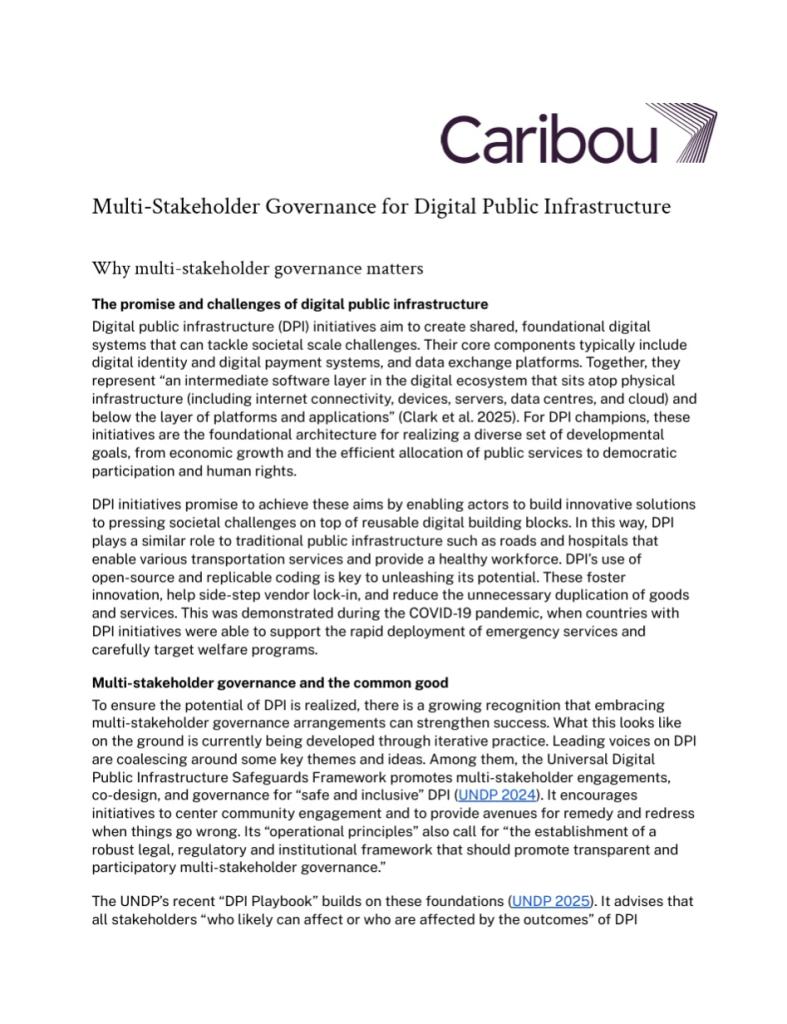It's Time to Talk About How We Actually Do Multi-Stakeholder Governance in Digital Public Infrastructure

As governments worldwide invest in digital public infrastructure, one question looms large: how can these systems be governed systems for the common good? This blog introduces a new paper by Caribou, supported by Co-Develop, that explores practical lessons from other sectors on making multi-stakeholder governance real, not rhetorical.
A recent Amazon Web Services 15-hour outage on October 20 disrupted services from Snapchat to banking platforms and brought into sharp relief how the world faces an increasingly fragile and fragmented digital future. At the same time, digital public infrastructure (DPI) has captured imaginations worldwide.
The promise is compelling: shared foundational digital systems—from identity platforms to payment systems and data exchanges—that enable innovation at societal scale. Countries with mature DPI weathered COVID-19 better, rapidly deploying emergency services and targeting welfare with precision. The success stories are inspiring.
But an important question often gets glossed over in the DPI hype cycle: how do we actually govern these systems in ways that serve the common good?
 It’s becoming clear that technical excellence alone won’t deliver on DPI’s transformative potential. Without robust governance involving diverse stakeholders—citizens, businesses, civil society, government—these initiatives risk becoming digital infrastructure projects rather than true digital public infrastructure. The difference matters immensely.
It’s becoming clear that technical excellence alone won’t deliver on DPI’s transformative potential. Without robust governance involving diverse stakeholders—citizens, businesses, civil society, government—these initiatives risk becoming digital infrastructure projects rather than true digital public infrastructure. The difference matters immensely.
Recent frameworks, such as the UNDP’s Digital Public Infrastructure Safeguards and the emerging Common Good Framework, are pointing the way forward by articulating principles centered on purpose, participation, learning, equity, and accountability. These principles sound right. They feel necessary. But concrete guidance on how governments can actually implement multi-stakeholder governance processes that bring these principles to life is sorely needed.
This is where things get interesting—and challenging for those committed to DPI. How do you set ambitious collective goals for DPI when stakeholders have vastly different levels of technical knowledge and competing interests? How do you ensure meaningful participation that goes beyond tokenism, especially when power inequalities structure every society? How do you build adaptive capacity to respond to rapid changes without losing coherence? How do you maintain trust at a societal scale? And when things inevitably go wrong in complex, decentralized systems, how do you ensure accountability without stifling innovation?
These aren’t rhetorical questions. They’re the practical challenges that governments championing DPI initiatives must navigate—often with limited precedent and under intense pressure to deliver results.
The good news? Those building DPI are not starting from scratch. Adjacent fields have been wrestling with similar challenges for decades. For example, the Open Government Partnership has experimented with multi-stakeholder forums across dozens of countries. Adaptive management approaches have transformed how development programs handle complexity. The extractive industries have developed sophisticated frameworks around “social license to operate.” Large-scale public-private partnerships have learned hard lessons about balancing diverse interests.
A new paper by Caribou, supported by Co-Develop, synthesizes insights from these fields, exploring how their tried-and-tested approaches to multi-stakeholder engagement could inform DPI governance. It examines concrete examples like Brazil’s PIX Forum, which convened banks, fintechs, small businesses, and civil society to collectively shape a payment system that has achieved remarkable adoption and equity. It explores how Mexico’s Open Government forum evolved to address power imbalances through innovative tripartite decision-making structures. It draws on mining projects’ experiences measuring and maintaining community trust at scale.
The paper doesn’t offer silver bullets. Instead, it does something more valuable: it maps the terrain of possibility, highlighting both opportunities and provocations around each principle of the Common Good Framework. It asks hard questions about when stakeholders should shape DPI’s direction, how governments can balance competing interests fairly, whether initiatives need protection from feedback or should embrace it from day one, and how regulatory frameworks can ensure accountability without crushing innovation.
Most importantly, the paper is an invitation. An invitation to deepen the conversation beyond principles and into practice. An invitation to learn from fields that have made mistakes so DPI doesn’t have to repeat them. An invitation to think seriously about multistakeholder governance as a core component of DPI success, not an afterthought.
If you’re involved in DPI initiatives—as a policymaker, implementer, civil society advocate, or technologist—these questions matter for your work. The decisions being made now about governance structures will shape whether DPI delivers on its promise of being truly public infrastructure that serves everyone, or becomes another digital system that concentrates benefits and leaves vulnerable populations behind.
The full paper offers a foundation for this deeper conversation, drawing together evidence, examples, and provocations to stimulate thinking and debate. It won’t answer every question, but it might help you ask better ones.
Download and read the paper to explore how multi-stakeholder governance can move from aspiration to implementation in DPI initiatives.
Dr. Emrys Schoemaker, Follow Dr. Emrys Schoemaker on LinkedIn, Senior Director, Advisory & Policy.
Dr Tom Kirk, Global Policy's Online Editor and London School of Economics and Political Science.
Photo by Google DeepMind


